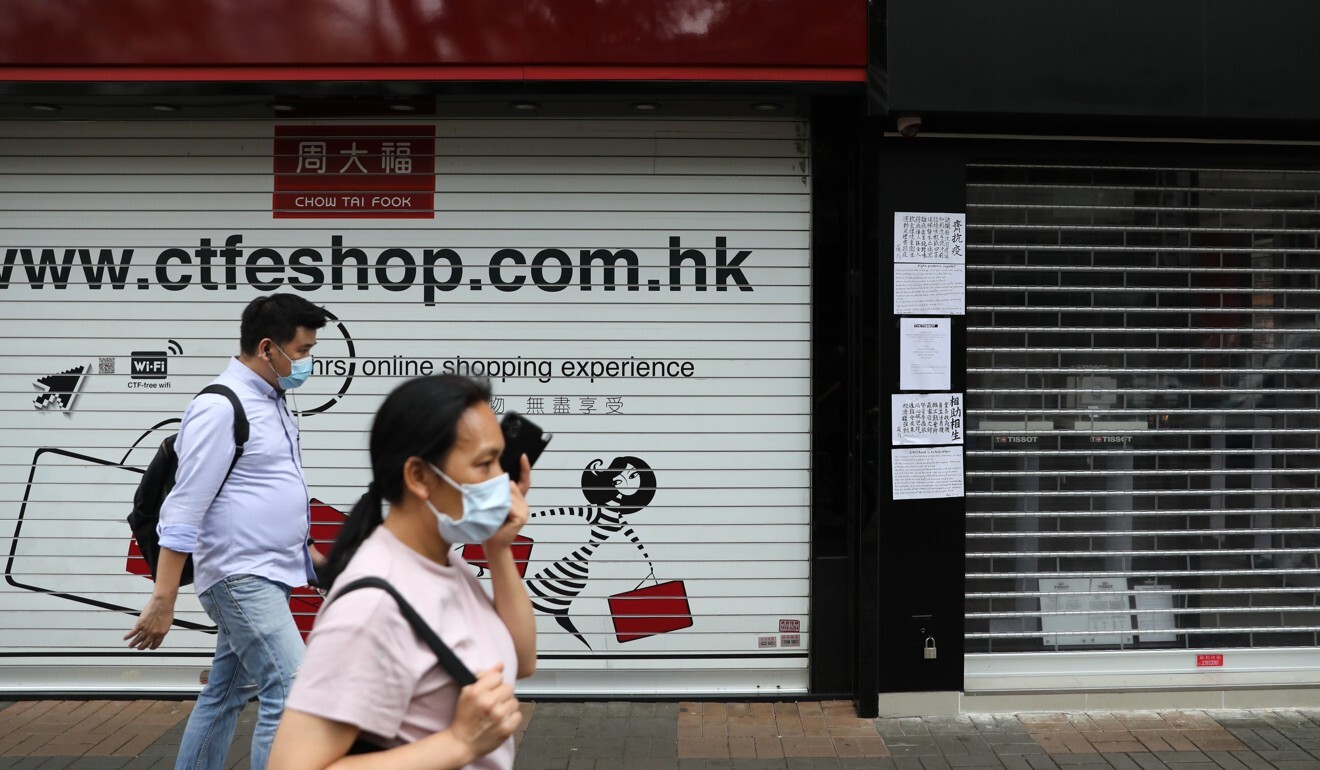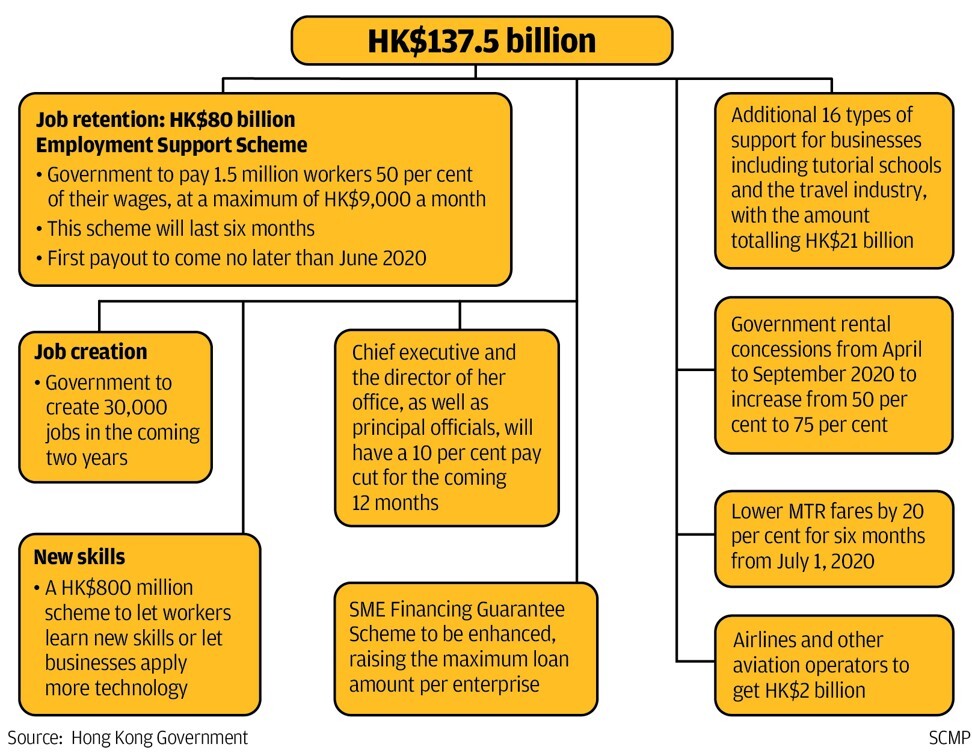
Coronavirus: Carrie Lam unveils Hong Kong’s biggest Covid-19 relief package yet, worth HK$138 billion, to ensure 1.5 million workers still get paid
- Hong Kong leader sets out six-month income guarantee to save jobs and firms amid ‘disastrous’ impact of Covid-19
- 30,000 new jobs created, lower train fares, billions more for businesses among other anti-contagion measures revealed as city’s infected total hits 960
Hong Kong’s embattled leader on Wednesday unveiled her government’s biggest coronavirus financial relief package so far, offering a HK$137.5 billion (US$18 billion) lifeline to save ailing businesses and ensure some 1.5 million workers would continue to get paid in the tough months ahead.
The government would also create 30,000 new jobs in the coming two years, spend billions on helping businesses not covered under earlier relief efforts, and lower train fares, among other measures, Lam said.
“In these unprecedented circumstances, the government must have some unprecedented responses – to help businesses to survive, safeguard employment, and minimise the burden on businesses and citizens,” she said.
“After we spend the money, we can earn it back because Hong Kong’s fundamentals are good. I’m confident we can get through this. We need to be united to fight the epidemic.”
The chief executive also announced she and her cabinet would take a 10 per cent pay cut for a year, which would see her monthly salary reduced to HK$390,000 after rising to HK$434,000 last July.
The HK$137.5 billion package, amounting to 4.8 per cent of the city’s gross domestic product, was approved by the Executive Council on Wednesday. Combined with previous financial relief offers, it would cost HK$287.5 billion, causing this year’s budget deficit to surge from HK$139.1 billion to HK$276.6 billion, equivalent to 9.5 per cent of GDP.
Hong Kong records 25 new cases, including two-month-old baby; tally at 960
The latest plan is to spend HK$80 billion on a six-month wage scheme for Hong Kong’s entire private sector, as long as employers make contributions to Mandatory Provident Fund schemes for workers.
Rather than workers receiving the money directly from the government, Lam said, employers would be reimbursed. The subsidy would be distributed to employers in two phases, starting before June.
“We have to try our best to prevent the closure of businesses or large-scale job cuts,” she said, laying down the condition that employers receiving financial aid must pledge not to lay off workers.
The administration would carry out random audit checks, and employers found to have sacked staff would have to return the money, along with extra payments, labour and welfare minister Dr Law Chi-kwong warned.
HK$21 billion has been set aside for 16 types of sectors and businesses hit especially hard, from aviation to smaller ventures such as education and tutorial centres and school bus operators.
Businesses forced to close, both permanently and temporarily, because of social-distancing measures are also set to benefit.
Subsidies for closed businesses will vary from HK$10,000 for individuals such as school bus operators and PE coaches, to HK$100,000 for gyms, game centres and beauty parlours.

For the general public, fares on railway services will also be discounted by 20 per cent for six months starting from July, with HK$1.6 billion in costs shared by the government and MTR Corporation. Five million passengers are expected to benefit from the measure.
Comparing her relief measures with those announced by other governments, Lam said Hong Kong’s were more generous and wide-ranging than Singapore’s, and in contrast with Britain, the city had focused on keeping employees working rather than supporting those who had lost their jobs.
The British government said last month it would pay grants covering up to 80 per cent of salaries if companies kept workers on the payroll rather than laying them off.
75 per cent of teachers polled seek further postponement of DSE exams
In Singapore, the government has offered to pay 75 per cent of workers’ April wages, capped at S$4,600 (HK$25,000) per person.
“In designing the employment support scheme, we have to ensure the money we are providing is reasonable to enable employers to keep employees in their jobs,” Lam said.
“If we provide too small an amount, employers will have difficulties keeping staff, but if we provide too large an amount, that’s a question of our affordability.”
The Hong Kong General Chamber of Commerce, a major business group in the city, welcomed the relief package, saying the wage subsidies in particular could help ease pressure on struggling companies.
“We stressed the need for swift action as this is paramount to saving jobs, so we are extremely relieved that the government has decided to introduce this $137.5 billion employment protection scheme,” chairman Aron Harilela said.
But social welfare lawmaker Shiu Ka-chun said even though the measure to safeguard jobs was helpful, officials had been too slow to act and many employees had already been laid off or asked to take unpaid leave after late January.
Covid-19 woes drive salary cuts, unpaid leave at Hong Kong Disneyland
In February, the Hong Kong government unveiled a HK$30 billion fund to help struggling sectors.
Financial Secretary Paul Chan Mo-po expected the government’s current fiscal reserve of some HK$1.1 trillion would drop to HK$800 billion to HK$900 billion, equivalent to about 15 months of public expenditure. Chan insisted the city’s public finances remained sound.
He expected Wednesday's package to help boost GDP by around 2 percentage points. All other relief measures since last August and this, worth around HK$320 billion in total, could drive the figure up by about 5 percentage points.





